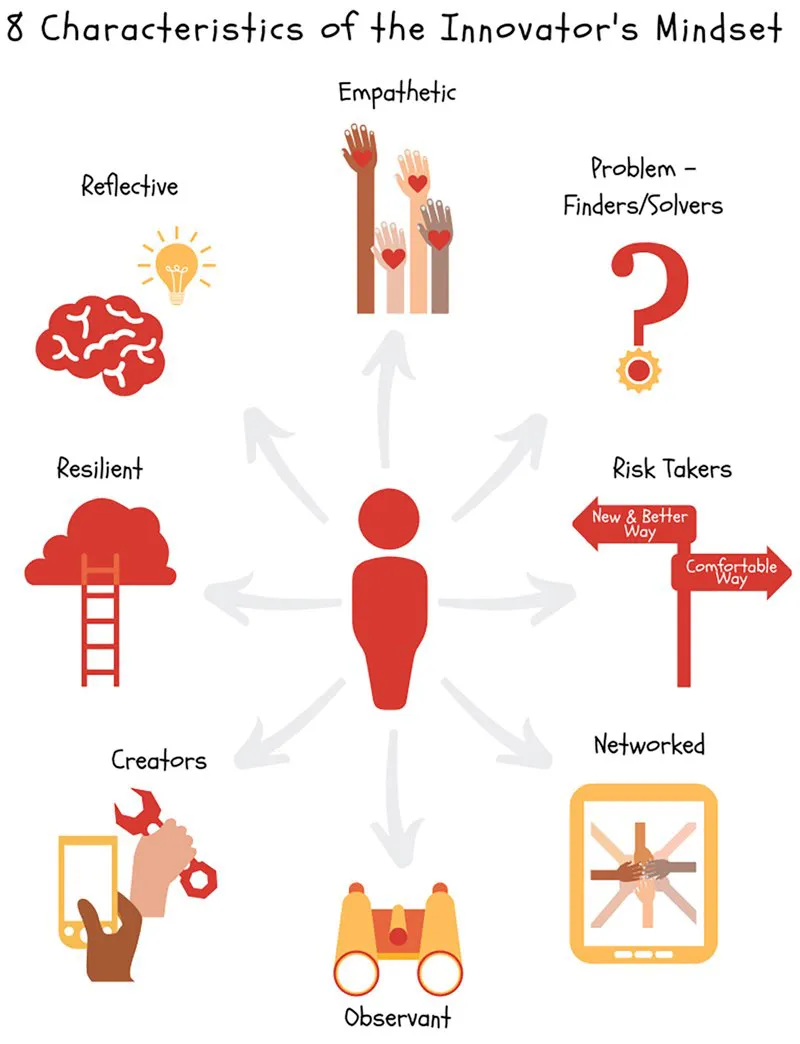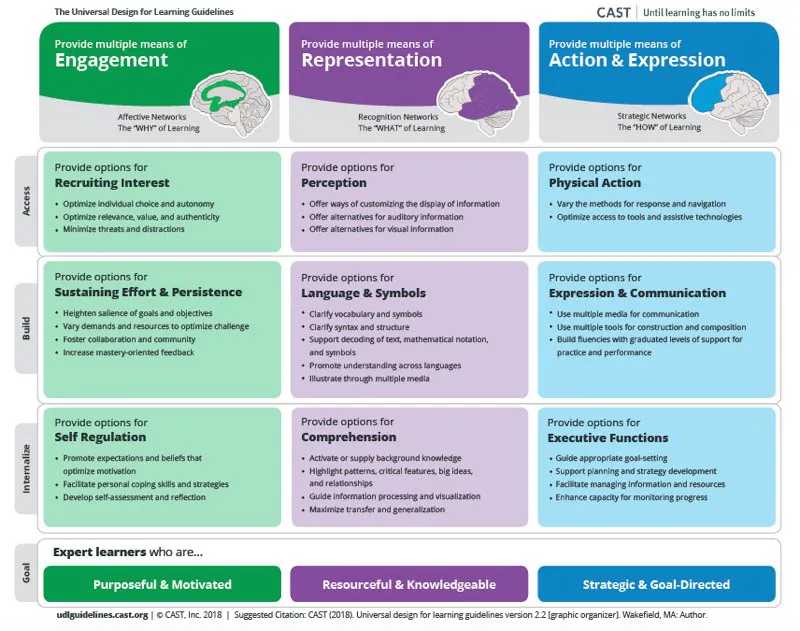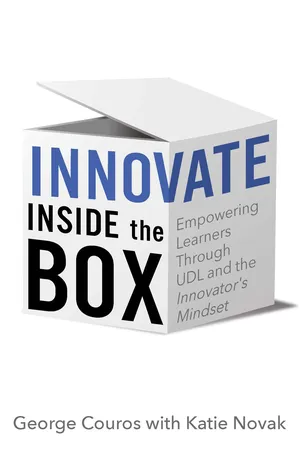In Part One, we focused on the Core of Innovative Teaching and Learning as the foundation of your practice as an educator. Part Two, which focuses on the 8 Characteristics of the Innovator’s Mindset, lays a similar foundation, but for our students. Here, Katie Novak will join the discussion as we examine each of these traits, discuss why they are important, and give examples of what this can look like in learning for our students today by implementing Universal Design for Learning (UDL). If Part One was setting the stage, Part Two is having students put on the production.

I am really excited to have Katie co-writing each chapter in Part Two. I was lucky enough to hear her speak on UDL when we gave back-to-back keynotes at the annual symposium for the California Curriculum and Instructional Services Steering Committee (CISC) in 2017. Katie’s philosophy and work within her own school district aligned perfectly with the “innovate inside the box” approach I’ve been advocating for the last several years: We can create empowering learning experiences for our students and have deep learning while doing well on traditional measures. Successful, innovative education does not have to be an either/or scenario. Katie’s district embodies the idea that how you teach the curriculum is the innovation. Teachers are artists, and as John Steinbeck wrote, “Teaching might even be the greatest of the arts since the medium is the human mind and spirit.”
I will open each chapter in Part Two with a focus on the why of each characteristic. Then Katie will share the what and the how. For the flow of the book and to keep writing true to our individual voices, you will see a simple “passing of the baton” symbol when we switch off. (Totally Katie’s idea!) I feel blessed to write this book with her. I have learned so much about great teaching and learning from not only what she shares but also how accessible her ideas are.
And with that, I introduce Katie Novak, one of the most brilliant educators I have met and just an all-around amazing person.

Learners are not disabled. Curriculum is. Systems are. But kids are not.
This is the essence of Universal Design for Learning (UDL). Our task, as educators, is to design learning experiences where all students can be equally empowered, challenged, and supported. To do this, we have to be proactive about identifying and eliminating barriers that prevent inclusive learning and innovation.
George discussed a number of ideas around how we can navigate the barriers to learning in Part One: developing meaningful relationships, evidence-based practices, empowered opportunities to learn, and a learning community proactively working together to change our systems. Granted, relationships, strong pedagogical practices, and empowered learners alone won’t be all that’s required to create great systems, but we sure as heck can’t change our systems without them. To give all students equal opportunities to learn, we have to be willing to examine our relationships, our own pedagogical practices, and the opportunities we create for students. Only then can we truly address some of the most significant barriers to high-quality education: inadequate resources, inequitable scheduling, curriculum bias, and state and federal policies, funding structures, and testing requirements that are not in the best interest of all students, especially those who are culturally and linguistically diverse.
We live in a world that embraces and encourages variability, the unique mix of strengths and weaknesses that make us who we are. We acknowledge this in restaurants where we enjoy diverse menus and clothing and shoe stores where we expect numerous styles and sizes. The school systems within which we operate, however, have not traditionally embraced variability. Many schools are still designed to provide a one-size-fits-all learning experience, which is neither accessible nor empowering for students or teachers.
As George noted in Chapter 3, “Nothing that has ever been deemed ‘best practice,’ however, works best for all students. Not. One. Thing.” I’m going to turn that into a bumper sticker and slap it on the back of my Suburban.
“One-size-fits-all” learning disables some students. To make sure students have the opportunities they need to help them learn best, we use the three UDL principles to design experiences that provide options for students:
- Provide multiple means of engagement.
- Provide multiple means of representation.
- Provide multiple means of action and expression.
The most basic example of the “one-size-fits-all” phenomenon, and how it can be transformed using the three principles of UDL, is a cookout. Imagine you’re having a diverse group of twenty-five people over to your house for a cookout. Operation Perfect Cookout is a one-size-fits-all shabang that includes a free giveaway of matching red bikinis (a single means of engagement), cheeseburgers (a single means of food representation), and karaoke with a live Jon Bon Jovi cover band (a single way for guests to “take action” and express their love of summer). Party. Of. The. Summer.
Then, your guests show up.
Suddenly, you realize that your party plan missed the mark. You were so psyched to get everyone motivated to show off their summer abs in a one-size-fits-all bathing suit— and they have the audacity to complain!? What do you mean that isn’t your style? It looks fine! Then your vegetarian, vegan, and lactose intolerant guests ask about food. Someone taps you on the shoulder, asking, “Do you have anything besides beef?” While you’re trying to scrounge up some lettuce, you overhear another guest complain about being forced to sing along to “Living on a Prayer.” (Who doesn’t like “Living on a Prayer”?)
Here’s the thing. In this scenario, you know that failure is predictable. Your party plans are riddled with barriers, and even a B-list party planner could tell you that. But, you argue, no one would ever throw a party with only one thing to eat or drink, or only one activity that everyone is forced to participate in. Instead, it would be planned with multiple options and pathways, just like we want our classrooms to be—hence the UDL principles.
UDL provides guidelines (specific strategies) regarding the types of options that students may need to learn. These guidelines also provide some party-planning support to help us proactively arrange for the perfect cookout. The UDL Guidelines are organized according to the three main principles of UDL that address engagement, representation, and action and expression. Think of these as the places where learners may face barriers to learning.
So if we use these guidelines when we plan our cookout, why don’t we use them in so many classrooms and schools?
Often, it’s because we believe or fear that we are required to take a one-way road to arrive at the formidable destination: “The Valley of Standardized Test” (cue the warnings from Chapter 2 on “Data-Based Decision Making”). This one-way path is paved with practice tests and other one-size-fits-all solutions for students who are anything but the same. Sounds kind of like the cookout from hell, doesn’t it?
As Jon Mundorf, a tremendous middle school educator in Florida and one of the greatest UDL experts in the country, said, “I would rather teach in an accessible way for an inaccessible test than teach in an inaccessible way for an inaccessible test.” We cannot test our way into increased test scores, and we sure as heck can’t empower students or embrace our own creativity and art that way. Or as George likes to say, “You don’t fatten a pig by constantly weighing it.”

Many students do not thrive in a one-size-fits-all system. The goal of school is not, and has never been, achieving high test scores and grade point averages. These are results that come when our students develop into expert learners. An expert learner is not a student who takes practice standardized tests ad nauseum, but one who becomes an expert at being an innovator by understanding the purpose of goals and standards and working toward those standards in ways that matter. In the book UDL Theory and Practice, written by the cofounders of UDL, expert learning is explained as follows:
Expertise is never static. Developing expertise in anything is always a process of continuous learning—practice, adjustment, and refinement. In the context of UDL, we focus on learning expertise: the lifelong process of becoming ever more motivated, knowledgeable, and skillful.1
Expert learning requires students to have multiple pathways to meet their needs. The concept of expert learning encompasses all eight characteristics of an innovator’s mindset, which we will highlight throughout Part Two of this book. If we want to improve teaching and learning, we have to create more equitable systems that empower educators and students to become problem solvers/finders, risk takers, creators, networked, empathetic, observant, resilient, and reflective. To accomplish this meaningful goal, educators need to design instruction using the three principles of UDL, so every student is empowered to know why learning is important, what it is they need to learn, and, most importantly, how to use the knowledge and skills to create something meaningful.
One of my greatest achievements as an administrator has been giving teachers the authority to create different pathways, using the principles of UDL to veer off the road that values sameness. It’s not that we don’t have to take standardized tests in my district. We do. But we don’t map our journey on the backs of those tests. Instead, we embrace expert learning and the great adventures that come with it—think Labyrinth meets Alice in Wonderland meets The Goonies (All the best parts!). We are risk takers, we make m...
